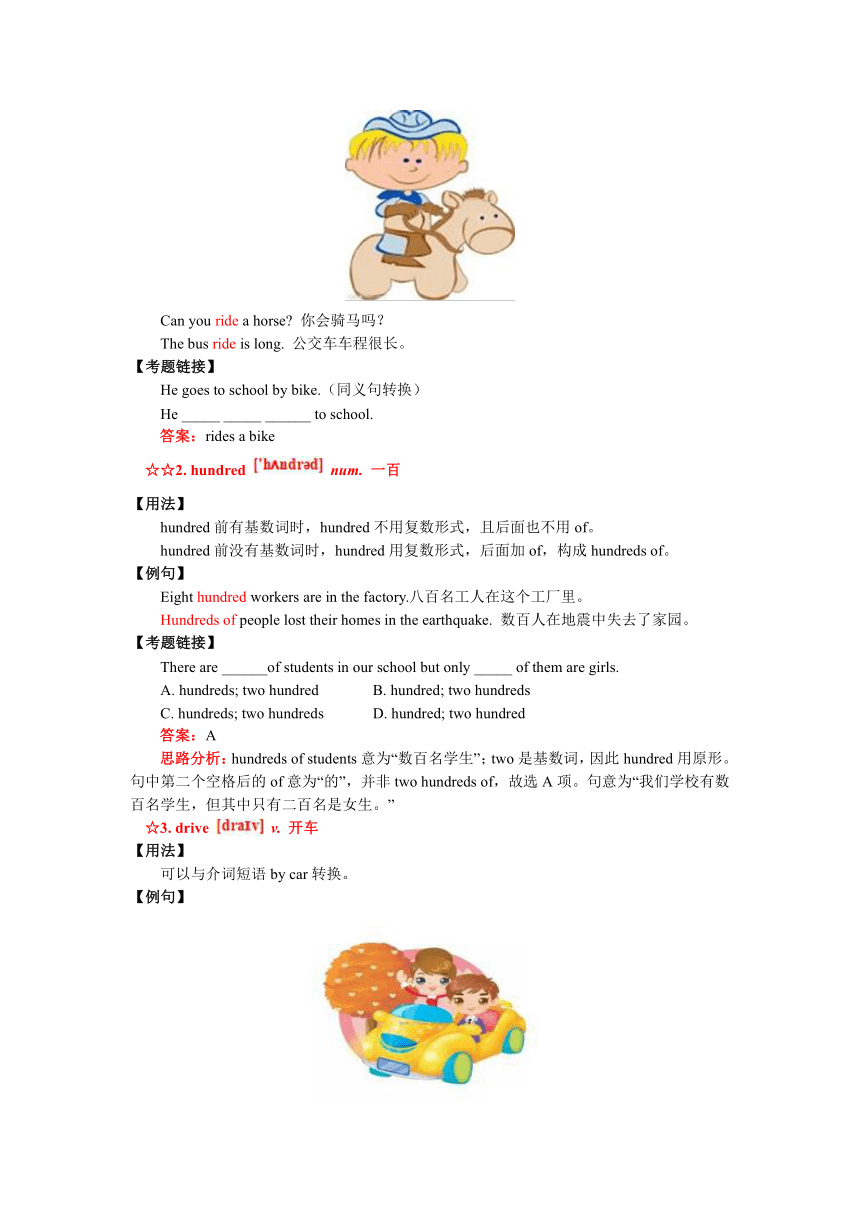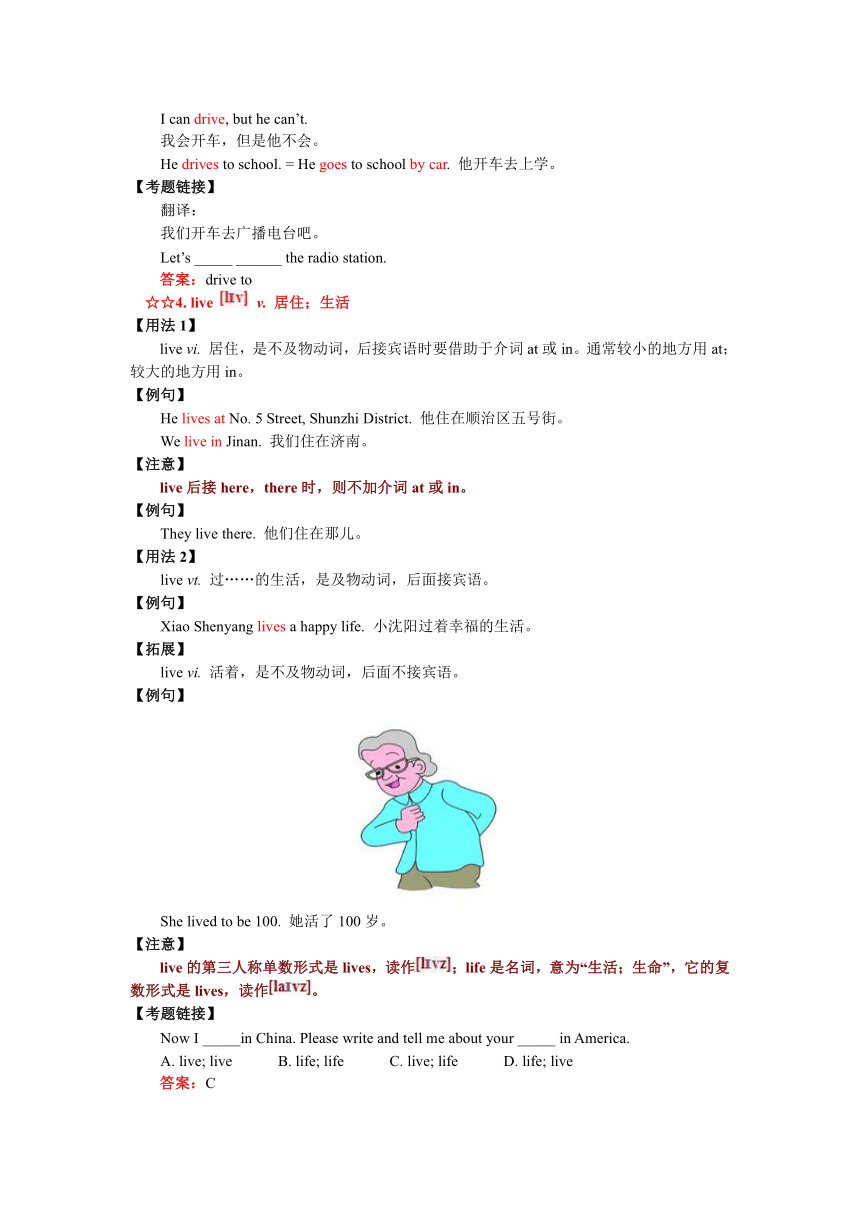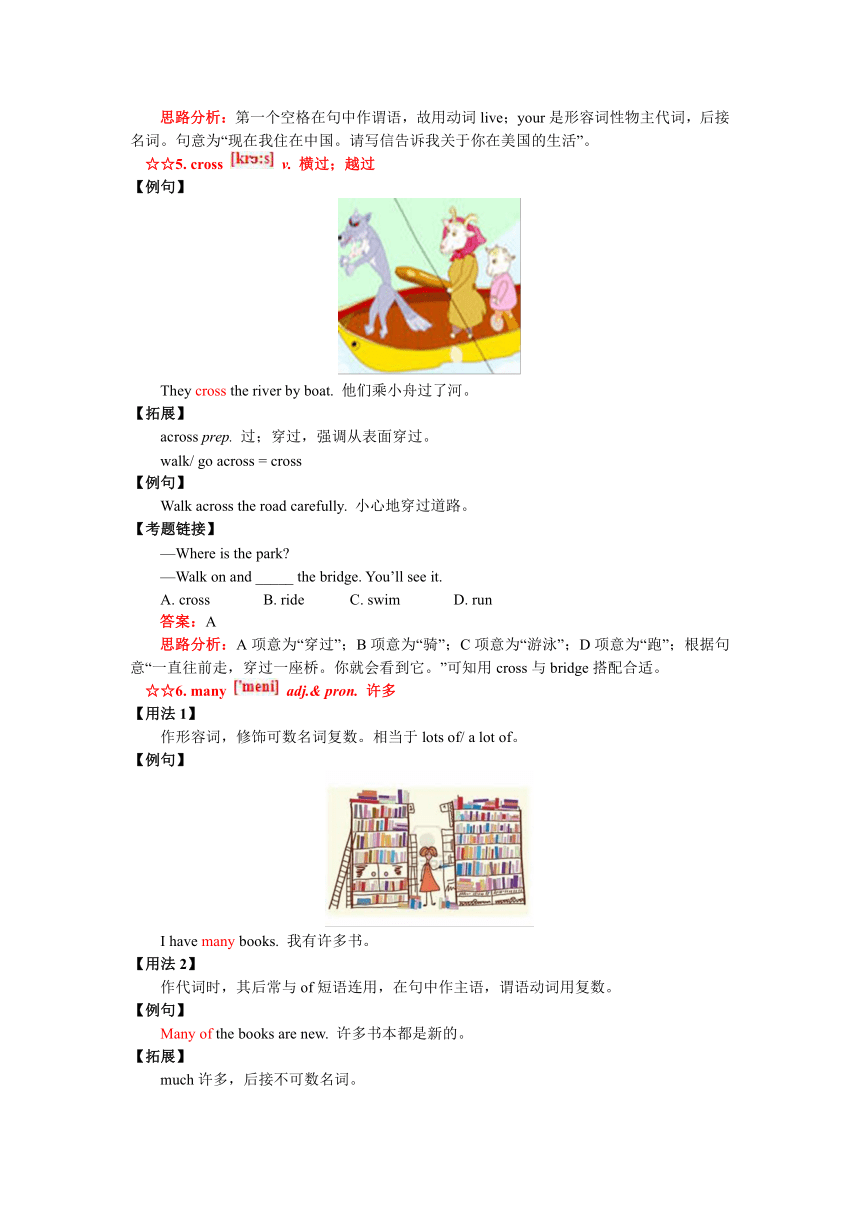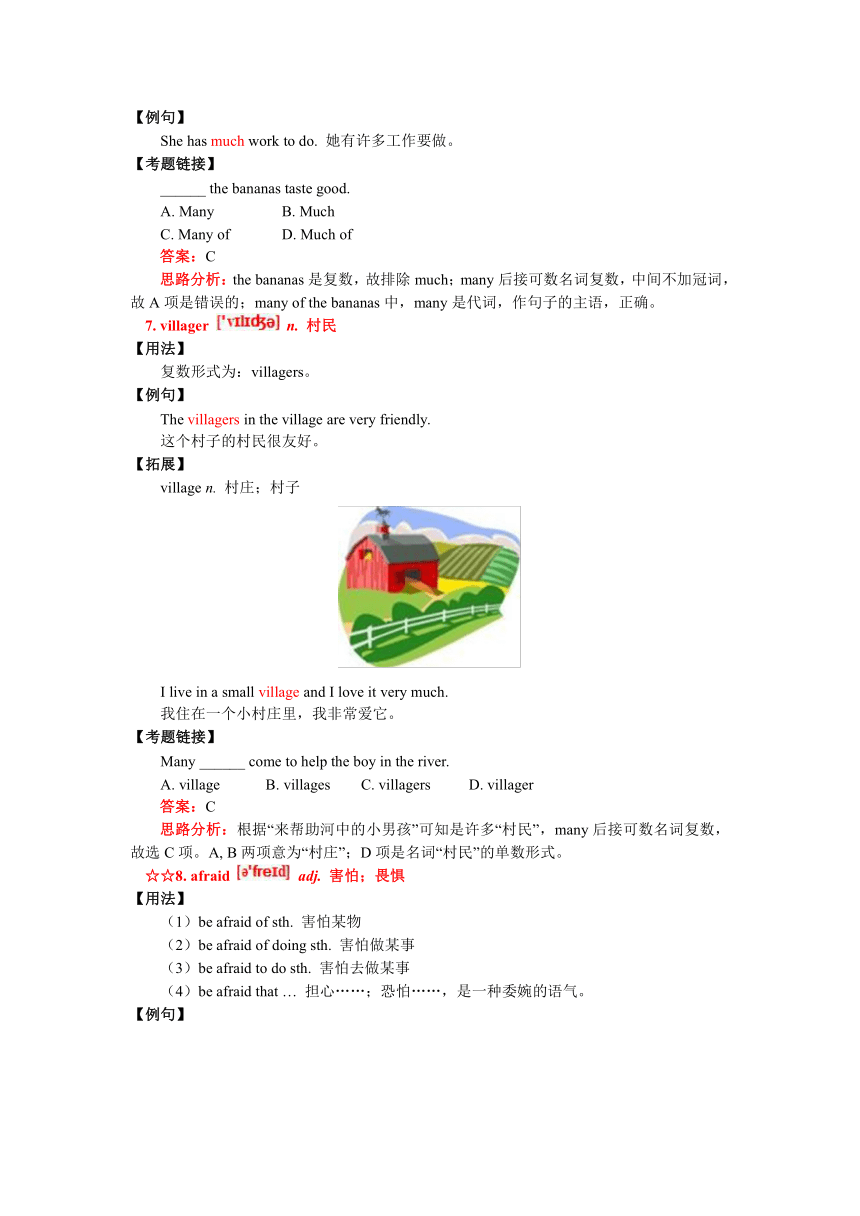Unit 5 How do you get to school?学案(含解析及练习)
文档属性
| 名称 | Unit 5 How do you get to school?学案(含解析及练习) |  | |
| 格式 | zip | ||
| 文件大小 | 1.5MB | ||
| 资源类型 | 教案 | ||
| 版本资源 | 鲁教版 | ||
| 科目 | 英语 | ||
| 更新时间 | 2019-04-01 08:08:44 | ||
图片预览





文档简介
How do you get to school?
学习目标:
1. 学习如何到达某地,掌握句型:
—How do you get to school?
—I walk.
—How does Mary get to school?
—She takes the subway.
2. 能谈论去某地的方式、距离、花费的时间。
重点、难点:
重点:
1. 单词:ride, hundred, drive, live, cross, many, villager, afraid, like, leave, dream
2. 短语:take the subway, every day, think of, one 11-year-old boy, between… and…, come true
3. 句型:
1)How far is it from your home to school? 从你家到学校多远?
2)How long does it take you to get to school? 到达学校花费你多长时间?
3)Mary wants to know what he thinks of the trip. 玛丽想知道他对这次旅行的看法。
4)For many students, it is easy to get to school. 对许多学生来说,到校很容易。
5)There is a big river between their school and the village.
在他们的学校和村庄之间有一条大河。
难点:
How引导的特殊疑问句。
一、单词领读
ride v. 骑 n. 旅程
drive v. 开车
live v. 居住
cross v. 横过;越过
leave v. 离开
dream v. 做梦 n. 梦想;睡梦
many adj. & pron. 许多
afraid adj. 害怕;畏惧
hundred num. 百
villager n. 村民
like prep. 像;怎么样
二、重点单词
【单词学习】
☆1. ride v. 骑 n. 旅程
【用法】
作动词时,常构成短语:ride a bike 骑自行车;ride a horse 骑马
【例句】
Can you ride a horse? 你会骑马吗?
The bus ride is long. 公交车车程很长。
【考题链接】
He goes to school by bike.(同义句转换)
He _____ _____ ______ to school.
答案:rides a bike
☆☆2. hundred num. 一百
【用法】
hundred前有基数词时,hundred不用复数形式,且后面也不用of。
hundred前没有基数词时,hundred用复数形式,后面加of,构成hundreds of。
【例句】
Eight hundred workers are in the factory.八百名工人在这个工厂里。
Hundreds of people lost their homes in the earthquake. 数百人在地震中失去了家园。
【考题链接】
There are ______of students in our school but only _____ of them are girls.
A. hundreds; two hundred B. hundred; two hundreds
C. hundreds; two hundreds D. hundred; two hundred
答案:A
思路分析:hundreds of students意为“数百名学生”;two是基数词,因此hundred用原形。句中第二个空格后的of意为“的”,并非two hundreds of,故选A项。句意为“我们学校有数百名学生,但其中只有二百名是女生。”
☆3. drive v. 开车
【用法】
可以与介词短语by car转换。
【例句】
I can drive, but he can’t.
我会开车,但是他不会。
He drives to school. = He goes to school by car. 他开车去上学。
【考题链接】
翻译:
我们开车去广播电台吧。
Let’s _____ ______ the radio station.
答案:drive to
☆☆4. live v. 居住;生活
【用法1】
live vi. 居住,是不及物动词,后接宾语时要借助于介词at或in。通常较小的地方用at;较大的地方用in。
【例句】
He lives at No. 5 Street, Shunzhi District. 他住在顺治区五号街。
We live in Jinan. 我们住在济南。
【注意】
live后接here,there时,则不加介词at或in。
【例句】
They live there. 他们住在那儿。
【用法2】
live vt. 过……的生活,是及物动词,后面接宾语。
【例句】
Xiao Shenyang lives a happy life. 小沈阳过着幸福的生活。
【拓展】
live vi. 活着,是不及物动词,后面不接宾语。
【例句】
She lived to be 100. 她活了100岁。
【注意】
live的第三人称单数形式是lives,读作;life是名词,意为“生活;生命”,它的复数形式是lives,读作。
【考题链接】
Now I _____in China. Please write and tell me about your _____ in America.
A. live; live B. life; life C. live; life D. life; live
答案:C
思路分析:第一个空格在句中作谓语,故用动词live;your是形容词性物主代词,后接名词。句意为“现在我住在中国。请写信告诉我关于你在美国的生活”。
☆☆5. cross v. 横过;越过
【例句】
They cross the river by boat. 他们乘小舟过了河。
【拓展】
across prep. 过;穿过,强调从表面穿过。
walk/ go across = cross
【例句】
Walk across the road carefully. 小心地穿过道路。
【考题链接】
—Where is the park?
—Walk on and _____ the bridge. You’ll see it.
A. cross B. ride C. swim D. run
答案:A
思路分析:A项意为“穿过”;B项意为“骑”;C项意为“游泳”;D项意为“跑”;根据句意“一直往前走,穿过一座桥。你就会看到它。”可知用cross与bridge搭配合适。
☆☆6. many adj.& pron. 许多
【用法1】
作形容词,修饰可数名词复数。相当于lots of/ a lot of。
【例句】
I have many books. 我有许多书。
【用法2】
作代词时,其后常与of短语连用,在句中作主语,谓语动词用复数。
【例句】
Many of the books are new. 许多书本都是新的。
【拓展】
much许多,后接不可数名词。
【例句】
She has much work to do. 她有许多工作要做。
【考题链接】
______ the bananas taste good.
A. Many B. Much
C. Many of D. Much of
答案:C
思路分析:the bananas是复数,故排除much;many后接可数名词复数,中间不加冠词,故A项是错误的;many of the bananas中,many是代词,作句子的主语,正确。
7. villager n. 村民
【用法】
复数形式为:villagers。
【例句】
The villagers in the village are very friendly.
这个村子的村民很友好。
【拓展】
village n. 村庄;村子
I live in a small village and I love it very much.
我住在一个小村庄里,我非常爱它。
【考题链接】
Many ______ come to help the boy in the river.
A. village B. villages C. villagers D. villager
答案:C
思路分析:根据“来帮助河中的小男孩”可知是许多“村民”,many后接可数名词复数,故选C项。A, B两项意为“村庄”;D项是名词“村民”的单数形式。
☆☆8. afraid adj. 害怕;畏惧
【用法】
(1)be afraid of sth. 害怕某物
(2)be afraid of doing sth. 害怕做某事
(3)be afraid to do sth. 害怕去做某事
(4)be afraid that … 担心……;恐怕……,是一种委婉的语气。
【例句】
She’s afraid of dogs. 她害怕狗。
He’s afraid of swimming. 他害怕游泳。
I’m afraid to speak in class. 我害怕在课堂上发言。
I’m afraid that I must go now. 恐怕我现在必须得走了。
【考题链接】
Some of the girls are afraid ____ in class.
A. to sing B. singing C. to singing D. sing
答案:A
思路分析:be afraid 后可接of sth./doing sth./to do sth.,也可接由that引导的从句,句中的sing是动词,所以可用of singing 或 to sing的形式,只有A项合适。
9. like prep. 像;怎么样
【用法】
常构成短语be like, look like;其反义词为unlike,意为“不像”。
【例句】
She is like her father very much. 她非常像她爸爸。
It looks like rain.天看起来要下雨。
What did she look like? 她长什么样子?
【拓展】
(1)like v. 喜欢;爱好,其反义词是dislike。
其后接名词、代词、动名词、动词不定式作宾语。
(2)like doing 表示习惯性的动作;like to do表示一次性的动作或未正在发生的动作。
【例句】
I like playing the guitar. 我喜欢弹吉他。
My father likes to talk with my teacher. 我爸爸喜欢和我老师谈话。
【考题链接】
Allan _____ sports, ______swimming.
A. like; like B. likes; likes C. like; likes D. likes; like
答案:D
思路分析:浏览题干可知第一空在句中作谓语,故用动词like;Allan是第三人称单数,故谓语动词用单三形式likes; swimming是sports的一种,故第二空用介词like,意为“像”。句意为“艾伦喜欢体育,像游泳”。
☆☆10. leave v. 离开
【例句】
The bus leaves at 8 am. 公共汽车上午八点出发。
【拓展】
(1)leave for 动身去某地
(2)leave v. 遗忘;留下,常构成短语 leave sth. somewhere 把某物忘在某地
(3)leave n. 假期
【例句】
He wants to leave for Shanghai. 他想动身去上海。
I left my keys at home. 我把我的钥匙忘在家中了。
She has two months’ leave every year. 她每年有两个月的假期。
11. dream n. 梦想;睡梦 v. 做梦
【例句】
I dreamed a good dream last night. 昨天晚上我做了一个好梦。
【拓展】
dream of/about 梦想;幻想;向往,of/about是介词,后接名词或动词的-ing形式。
【例句】
He dreams of becoming an actor. 他一心想当演员。
【考题链接】
He often ____ becoming a scientist in the future.
A. gets up B. gets to C. dreams of D. looks at
答案:C
思路分析:A项意为“起床”;B项意为“到达”;C项意为“梦想”;D项意为“看……”;句意为“他经常梦想未来当一名科学家”。
【即学即练】
根据汉语提示完成句子
1. The train ______(旅程)takes about four hours.
2. He ______(开车)to work every day.
3. My grandmother ______(居住)in a small village.
4. He can tell us two ______(百)stories.
5. I have ______(许多)friends.
6. The ______(村民)live far from the city.
7. How can he ______(越过)the river?
8. When do you ______(离开)for Beijing?
9. The boy is ______(害怕)to meet new people.
10. In his ______(睡梦), he rides a white horse.
答案:1. ride 2. drives 3. lives 4. hundred 5. many
6. villagers 7. cross 8. leave 9. afraid 10. dream
三、重点短语
【短语学习】
☆☆1. take the subway 乘地铁
【用法】
take +a/the +交通工具,表示“使用某种交通工具”,在句中作谓语。
【例句】
It’s far from here. Let’s take a taxi. 它离这儿远。咱们乘出租车吧。
Li Lei often takes a plane to Guangzhou. 李雷经常乘飞机去广州。
【拓展】
by +交通工具,表示“使用某种交通工具”,在句中作状语。
【例句】
We go to school by school bus. 我们乘校车去上学。
【考题链接】
I usually go to work ______ car. But today I want to ____ the train to work.
A. by; by B. by; take C. take; by D. take; take
答案:B
思路分析:前句有谓语动词,故“乘小汽车”用by car;后句中to后接动词原形,故用take。
☆☆2. every day 每天
【用法】
在句中作时间状语。
【例句】
We watch TV every day. 我们天天看电视。
【拓展】
everyday adj. 日常的;每日的,是形容词,在句中作定语。
【例句】
Everyday English is not difficult. 日常英语不难。
【考题链接】
Students learn ____ English ____.
A. every day; every day B. everyday; everyday
C. every day; everyday D. everyday; every day
答案:D
思路分析:English是名词“英文”,其前用形容词修饰,故排除A,C两项;句意为“学生们每天学习日常英语。”故后一个空用every day,排除B项。
3. think of 认为
【用法】
of是介词,其后可接名词、代词、动词的-ing形式。相当于think about。
【例句】
What do you think of the food? 你认为这食物怎样?
【考题链接】
翻译:
他认为那俱乐部怎么样?
What ______ he ______ ______ the club?
答案:does; think of/about
☆☆4. one 11-year-old boy 一个11岁的男孩
【用法】
11-year-old 11岁的,作前置定语,修饰名词。
“数词+名词(单数形式)+形容词”是复合形容词,中间加连字符。
【例句】
This is a nine-year-old boy. 这是一位九岁的小男孩。
【拓展】
数词+名词(复数形式)+形容词,中间不加连字符,作表语。
【例句】
The classroom is 15 meters long. 这教室15米长。
【考题链接】
I have _______ sister.
A. a 8-year-old B. a 8 years old C. an 8-year-old D. an 8 years old
答案:C
思路分析:sister是名词,故其前用复合形容词修饰,即中间加连字符;8(eight)的首音素是元音,故其前用an修饰。选项C正确。句意为“我有一个八岁的妹妹”。
5. between…and… 在……和……之间
【用法】
着重指两者之间;between和and之间的两者可以是两个人,也可以是两个不同的物或两个时间点。between后接人称代词时要用宾格形式。
【例句】
He sits between you and me. 他坐在你和我之间。
The shop opens between 8 a.m. and 5 p.m.. 商店在上午8点和下午5点之间营业。
【考题链接】
Don’t tell anybody about it, keep it _____ you and me.
A. with B. in C. between D. next
答案:C
思路分析:with表示“和;与”;in表示“在……范围中”;between表示“在两者之间”;next 表示“紧靠……的旁边”。在you and me之间用between。
6. come true 实现;成为现实
【例句】
His dream came true at last. 他的梦想最终实现了。
【考题链接】
翻译:
我的梦想能够实现的。
My ______ can ______ ______.
答案:dream; come true
【即学即练】
英汉互译
1. every day __________ 2. 在……和……之间 ______________
3. everyday __________ 4. 认为 ___________
5. look like __________ 6. 实现;成为现实 __________
7. take the bus _______ 8. 一个八岁的女孩 __________
答案:1. 每天 2. between… and … 3. 每天的;日常的 4. think of / about
5. 看起来像 6. come true 7. 乘公共汽车 8. an 8-year-old girl
四、重点句型
【句型学习】
1. How far is it from your home to school? 从你家到学校多远?
【句析】
本句是一个由how far引导的特殊疑问句。
【考点】
how far多远,用来对距离进行提问,原句可改为:
How far is your home from school? 你家离学校多远?
【考题链接】
—How far is it from the park to the library?
—It’s _______.
A. five minutes walk B. an hour from here
C. three kilometers far D. about one hundred meters away
答案:D
思路分析:时间作定语要用所有格形式,排除A项;B项没说清方式;far不能与具体的数量词搭配,故C项也不正确;away可与具体的数量词搭配。句意为“—从公园到图书馆多远?—大约一百米远。”
2. How long does it take you to get to school? 到达学校花费你多长时间?
【句析】
本句是由how long引导的特殊疑问句。
【考点】
take v. 花费(时间),常用句式为:It takes sb. some time to do sth. 意为“做某事花费某人多少时间”。it是形式主语,动词不定式是真正的主语。
【例句】
How long will it take you to finish the work? 完成这项工作将花费你多长时间?
【拓展】
(1)take v. 拿走;带走
take sth. to sb. 把某物带给某人
take sb. to somewhere. 把某人带到某地
(2)take v. 买下
(3)take v. 服用(药物)
【例句】
Please take some oranges to me. 请带给我一些橙子。
I’ll take this sweater. 我要买下这件毛衣。
Take this medicine and have a good rest. 吃下这药并好好休息。
【考题链接】
It takes me two hours ______ my homework.
A. do B. to doing C. finish D. to finish
答案:D
思路分析:本题考查It takes sb. some time to do sth. 即:做某事花费某人多长时间。其后用动词不定式。浏览各选项,只有D项合适。
3. Mary wants to know what he thinks of the trip. 玛丽想知道他对这次旅行的看法。
【句析】
本句是一个含有宾语从句的复合句。what he thinks of the trip作know的宾语。在宾语从句中,语序用陈述句语序,即主语、谓语的顺序。
【例句】
Do you know what he likes for lunch? 你知道他午饭喜欢吃什么吗?
Please tell me when he gets up in the morning. 请告诉我他早上什么时候起床。
【考题链接】
—Do you know ________?
—On March 22nd.
A. when is the World Water Day B. where is the World Water Day
C. when the World Water Day is D. where the World Water Day is
答案:C
思路分析:根据答语中的时间可知问句是由when引导的宾语从句;在宾语从句中,语序用陈述句语序,故选C项。
4. For many students, it is easy to get to school. 对许多学生来说,到校很容易。
【句析】
本句是一个简单句。句中使用了句型:It’s +adj.+ to do sth. 做某事是……的。其中it是形式主语,真正的主语是动词不定式。
【例句】
It’s relaxing to watch TV. 看电视是很令人放松的。
【拓展】
(1)It is +adj. +(for sb.)+ to do sth 表示“对某人来说做某事怎样”。
(2)It’s +adj. +(of sb.)+ to do sth. 表示“某人做某事是怎样的”。
【例句】
It’s not easy for you to study English well. 对你来说学好英语是不容易的。
It’s nice of you to help me. 你来帮助我真是太好了。
【考题链接】
It’s not easy ______ well.
A. swim B. to swim C. swims D. swimming
答案:B
思路分析:浏览题干可知it是形式主语,真正的主语是动词不定式。故B项正确。
5. There is a big river between their school and the village.
在他们的学校和村庄之间有一条大河。
【句析】
本句属there be句型。
【考点】
(1)表示“某地存在某人/物”,它的构成形式一般为There are/is+某物/人+地点。它既可以表示某地方有什么东西,也可以表示某地方有什么人。
(2)be的单复数取决于其后的主语,单数主语用is,复数主语全用are;如为并列主语,be随第一主语变,即就近原则。
【例句】
There are many students in the classroom. 教室里有很多学生。
There is an apple on the desk. 桌子上有个苹果。
There is a pen and two erasers on the desk. 课桌上有一支钢笔和两块橡皮。
There are two erasers and a pen on the desk. 课桌上有两块橡皮和一支钢笔。
【考题链接】
There _____ a hotel, a school and two shops on the street.
A. is B. are C. have D. has
答案:A
思路分析:浏览题干可知句意为“在这条街上有一家旅馆、一所学校和两家商店”。表示某地存在某物,故用there be句型;如为并列主语,be随第一个主语改变,即就近原则。a hotel是第一个主语,是单数,故谓语动词用单数形式is。
【即学即练】
Ⅰ. 单项选择
1. ______ is important for all of us to take exercise.
A. This B. That C. It D. One
2. —______is it from here to your home?
—It’s about 10 kilometers.
A. How B. How long C. How far D. How much
3. How long does it take you ______the river?
A. cross B. to cross C. crossing D. crosses
4. I want to know _________.
A. who teaches you math B. who does teach you math
C. who teaches your math D. who does teach your math
Ⅱ. 用be的正确形式填空
1. There ______ some apples on the table.
2. There ______ some bread on the table.
3. There ______ a set of keys on the sofa.
Ⅲ. 根据汉语意思完成下列句子
1. 你能把那本笔记本带给我吗?
Can you _____ the notebook _____ me?
2. 这把吉他很不错。我要买下它。
This guitar is very good. I’ll _____ it.
3. 你可以服用这药。
You can _____ this medicine.
答案:Ⅰ. 1. C 2. C 3. B 4. A
思路分析:
1. 能充当形式主语的是it,真正的主语是动词不定式。
2. 根据答语“大约10公里”可知问句询问距离,故用How far。
3. It takes sb. to do sth. 是固定结构,故选B项。
4. 浏览各选项可知设空处为宾语从句,在宾语从句中,语序用陈述句语序,排除B, D两项;teach后接双宾语,故排除C项,只有A项正确。
Ⅱ. 1. are 2. is 3. is
Ⅲ. 1. take; to 2. take 3. take
学习目标:
1. 学习如何到达某地,掌握句型:
—How do you get to school?
—I walk.
—How does Mary get to school?
—She takes the subway.
2. 能谈论去某地的方式、距离、花费的时间。
重点、难点:
重点:
1. 单词:ride, hundred, drive, live, cross, many, villager, afraid, like, leave, dream
2. 短语:take the subway, every day, think of, one 11-year-old boy, between… and…, come true
3. 句型:
1)How far is it from your home to school? 从你家到学校多远?
2)How long does it take you to get to school? 到达学校花费你多长时间?
3)Mary wants to know what he thinks of the trip. 玛丽想知道他对这次旅行的看法。
4)For many students, it is easy to get to school. 对许多学生来说,到校很容易。
5)There is a big river between their school and the village.
在他们的学校和村庄之间有一条大河。
难点:
How引导的特殊疑问句。
一、单词领读
ride v. 骑 n. 旅程
drive v. 开车
live v. 居住
cross v. 横过;越过
leave v. 离开
dream v. 做梦 n. 梦想;睡梦
many adj. & pron. 许多
afraid adj. 害怕;畏惧
hundred num. 百
villager n. 村民
like prep. 像;怎么样
二、重点单词
【单词学习】
☆1. ride v. 骑 n. 旅程
【用法】
作动词时,常构成短语:ride a bike 骑自行车;ride a horse 骑马
【例句】
Can you ride a horse? 你会骑马吗?
The bus ride is long. 公交车车程很长。
【考题链接】
He goes to school by bike.(同义句转换)
He _____ _____ ______ to school.
答案:rides a bike
☆☆2. hundred num. 一百
【用法】
hundred前有基数词时,hundred不用复数形式,且后面也不用of。
hundred前没有基数词时,hundred用复数形式,后面加of,构成hundreds of。
【例句】
Eight hundred workers are in the factory.八百名工人在这个工厂里。
Hundreds of people lost their homes in the earthquake. 数百人在地震中失去了家园。
【考题链接】
There are ______of students in our school but only _____ of them are girls.
A. hundreds; two hundred B. hundred; two hundreds
C. hundreds; two hundreds D. hundred; two hundred
答案:A
思路分析:hundreds of students意为“数百名学生”;two是基数词,因此hundred用原形。句中第二个空格后的of意为“的”,并非two hundreds of,故选A项。句意为“我们学校有数百名学生,但其中只有二百名是女生。”
☆3. drive v. 开车
【用法】
可以与介词短语by car转换。
【例句】
I can drive, but he can’t.
我会开车,但是他不会。
He drives to school. = He goes to school by car. 他开车去上学。
【考题链接】
翻译:
我们开车去广播电台吧。
Let’s _____ ______ the radio station.
答案:drive to
☆☆4. live v. 居住;生活
【用法1】
live vi. 居住,是不及物动词,后接宾语时要借助于介词at或in。通常较小的地方用at;较大的地方用in。
【例句】
He lives at No. 5 Street, Shunzhi District. 他住在顺治区五号街。
We live in Jinan. 我们住在济南。
【注意】
live后接here,there时,则不加介词at或in。
【例句】
They live there. 他们住在那儿。
【用法2】
live vt. 过……的生活,是及物动词,后面接宾语。
【例句】
Xiao Shenyang lives a happy life. 小沈阳过着幸福的生活。
【拓展】
live vi. 活着,是不及物动词,后面不接宾语。
【例句】
She lived to be 100. 她活了100岁。
【注意】
live的第三人称单数形式是lives,读作;life是名词,意为“生活;生命”,它的复数形式是lives,读作。
【考题链接】
Now I _____in China. Please write and tell me about your _____ in America.
A. live; live B. life; life C. live; life D. life; live
答案:C
思路分析:第一个空格在句中作谓语,故用动词live;your是形容词性物主代词,后接名词。句意为“现在我住在中国。请写信告诉我关于你在美国的生活”。
☆☆5. cross v. 横过;越过
【例句】
They cross the river by boat. 他们乘小舟过了河。
【拓展】
across prep. 过;穿过,强调从表面穿过。
walk/ go across = cross
【例句】
Walk across the road carefully. 小心地穿过道路。
【考题链接】
—Where is the park?
—Walk on and _____ the bridge. You’ll see it.
A. cross B. ride C. swim D. run
答案:A
思路分析:A项意为“穿过”;B项意为“骑”;C项意为“游泳”;D项意为“跑”;根据句意“一直往前走,穿过一座桥。你就会看到它。”可知用cross与bridge搭配合适。
☆☆6. many adj.& pron. 许多
【用法1】
作形容词,修饰可数名词复数。相当于lots of/ a lot of。
【例句】
I have many books. 我有许多书。
【用法2】
作代词时,其后常与of短语连用,在句中作主语,谓语动词用复数。
【例句】
Many of the books are new. 许多书本都是新的。
【拓展】
much许多,后接不可数名词。
【例句】
She has much work to do. 她有许多工作要做。
【考题链接】
______ the bananas taste good.
A. Many B. Much
C. Many of D. Much of
答案:C
思路分析:the bananas是复数,故排除much;many后接可数名词复数,中间不加冠词,故A项是错误的;many of the bananas中,many是代词,作句子的主语,正确。
7. villager n. 村民
【用法】
复数形式为:villagers。
【例句】
The villagers in the village are very friendly.
这个村子的村民很友好。
【拓展】
village n. 村庄;村子
I live in a small village and I love it very much.
我住在一个小村庄里,我非常爱它。
【考题链接】
Many ______ come to help the boy in the river.
A. village B. villages C. villagers D. villager
答案:C
思路分析:根据“来帮助河中的小男孩”可知是许多“村民”,many后接可数名词复数,故选C项。A, B两项意为“村庄”;D项是名词“村民”的单数形式。
☆☆8. afraid adj. 害怕;畏惧
【用法】
(1)be afraid of sth. 害怕某物
(2)be afraid of doing sth. 害怕做某事
(3)be afraid to do sth. 害怕去做某事
(4)be afraid that … 担心……;恐怕……,是一种委婉的语气。
【例句】
She’s afraid of dogs. 她害怕狗。
He’s afraid of swimming. 他害怕游泳。
I’m afraid to speak in class. 我害怕在课堂上发言。
I’m afraid that I must go now. 恐怕我现在必须得走了。
【考题链接】
Some of the girls are afraid ____ in class.
A. to sing B. singing C. to singing D. sing
答案:A
思路分析:be afraid 后可接of sth./doing sth./to do sth.,也可接由that引导的从句,句中的sing是动词,所以可用of singing 或 to sing的形式,只有A项合适。
9. like prep. 像;怎么样
【用法】
常构成短语be like, look like;其反义词为unlike,意为“不像”。
【例句】
She is like her father very much. 她非常像她爸爸。
It looks like rain.天看起来要下雨。
What did she look like? 她长什么样子?
【拓展】
(1)like v. 喜欢;爱好,其反义词是dislike。
其后接名词、代词、动名词、动词不定式作宾语。
(2)like doing 表示习惯性的动作;like to do表示一次性的动作或未正在发生的动作。
【例句】
I like playing the guitar. 我喜欢弹吉他。
My father likes to talk with my teacher. 我爸爸喜欢和我老师谈话。
【考题链接】
Allan _____ sports, ______swimming.
A. like; like B. likes; likes C. like; likes D. likes; like
答案:D
思路分析:浏览题干可知第一空在句中作谓语,故用动词like;Allan是第三人称单数,故谓语动词用单三形式likes; swimming是sports的一种,故第二空用介词like,意为“像”。句意为“艾伦喜欢体育,像游泳”。
☆☆10. leave v. 离开
【例句】
The bus leaves at 8 am. 公共汽车上午八点出发。
【拓展】
(1)leave for 动身去某地
(2)leave v. 遗忘;留下,常构成短语 leave sth. somewhere 把某物忘在某地
(3)leave n. 假期
【例句】
He wants to leave for Shanghai. 他想动身去上海。
I left my keys at home. 我把我的钥匙忘在家中了。
She has two months’ leave every year. 她每年有两个月的假期。
11. dream n. 梦想;睡梦 v. 做梦
【例句】
I dreamed a good dream last night. 昨天晚上我做了一个好梦。
【拓展】
dream of/about 梦想;幻想;向往,of/about是介词,后接名词或动词的-ing形式。
【例句】
He dreams of becoming an actor. 他一心想当演员。
【考题链接】
He often ____ becoming a scientist in the future.
A. gets up B. gets to C. dreams of D. looks at
答案:C
思路分析:A项意为“起床”;B项意为“到达”;C项意为“梦想”;D项意为“看……”;句意为“他经常梦想未来当一名科学家”。
【即学即练】
根据汉语提示完成句子
1. The train ______(旅程)takes about four hours.
2. He ______(开车)to work every day.
3. My grandmother ______(居住)in a small village.
4. He can tell us two ______(百)stories.
5. I have ______(许多)friends.
6. The ______(村民)live far from the city.
7. How can he ______(越过)the river?
8. When do you ______(离开)for Beijing?
9. The boy is ______(害怕)to meet new people.
10. In his ______(睡梦), he rides a white horse.
答案:1. ride 2. drives 3. lives 4. hundred 5. many
6. villagers 7. cross 8. leave 9. afraid 10. dream
三、重点短语
【短语学习】
☆☆1. take the subway 乘地铁
【用法】
take +a/the +交通工具,表示“使用某种交通工具”,在句中作谓语。
【例句】
It’s far from here. Let’s take a taxi. 它离这儿远。咱们乘出租车吧。
Li Lei often takes a plane to Guangzhou. 李雷经常乘飞机去广州。
【拓展】
by +交通工具,表示“使用某种交通工具”,在句中作状语。
【例句】
We go to school by school bus. 我们乘校车去上学。
【考题链接】
I usually go to work ______ car. But today I want to ____ the train to work.
A. by; by B. by; take C. take; by D. take; take
答案:B
思路分析:前句有谓语动词,故“乘小汽车”用by car;后句中to后接动词原形,故用take。
☆☆2. every day 每天
【用法】
在句中作时间状语。
【例句】
We watch TV every day. 我们天天看电视。
【拓展】
everyday adj. 日常的;每日的,是形容词,在句中作定语。
【例句】
Everyday English is not difficult. 日常英语不难。
【考题链接】
Students learn ____ English ____.
A. every day; every day B. everyday; everyday
C. every day; everyday D. everyday; every day
答案:D
思路分析:English是名词“英文”,其前用形容词修饰,故排除A,C两项;句意为“学生们每天学习日常英语。”故后一个空用every day,排除B项。
3. think of 认为
【用法】
of是介词,其后可接名词、代词、动词的-ing形式。相当于think about。
【例句】
What do you think of the food? 你认为这食物怎样?
【考题链接】
翻译:
他认为那俱乐部怎么样?
What ______ he ______ ______ the club?
答案:does; think of/about
☆☆4. one 11-year-old boy 一个11岁的男孩
【用法】
11-year-old 11岁的,作前置定语,修饰名词。
“数词+名词(单数形式)+形容词”是复合形容词,中间加连字符。
【例句】
This is a nine-year-old boy. 这是一位九岁的小男孩。
【拓展】
数词+名词(复数形式)+形容词,中间不加连字符,作表语。
【例句】
The classroom is 15 meters long. 这教室15米长。
【考题链接】
I have _______ sister.
A. a 8-year-old B. a 8 years old C. an 8-year-old D. an 8 years old
答案:C
思路分析:sister是名词,故其前用复合形容词修饰,即中间加连字符;8(eight)的首音素是元音,故其前用an修饰。选项C正确。句意为“我有一个八岁的妹妹”。
5. between…and… 在……和……之间
【用法】
着重指两者之间;between和and之间的两者可以是两个人,也可以是两个不同的物或两个时间点。between后接人称代词时要用宾格形式。
【例句】
He sits between you and me. 他坐在你和我之间。
The shop opens between 8 a.m. and 5 p.m.. 商店在上午8点和下午5点之间营业。
【考题链接】
Don’t tell anybody about it, keep it _____ you and me.
A. with B. in C. between D. next
答案:C
思路分析:with表示“和;与”;in表示“在……范围中”;between表示“在两者之间”;next 表示“紧靠……的旁边”。在you and me之间用between。
6. come true 实现;成为现实
【例句】
His dream came true at last. 他的梦想最终实现了。
【考题链接】
翻译:
我的梦想能够实现的。
My ______ can ______ ______.
答案:dream; come true
【即学即练】
英汉互译
1. every day __________ 2. 在……和……之间 ______________
3. everyday __________ 4. 认为 ___________
5. look like __________ 6. 实现;成为现实 __________
7. take the bus _______ 8. 一个八岁的女孩 __________
答案:1. 每天 2. between… and … 3. 每天的;日常的 4. think of / about
5. 看起来像 6. come true 7. 乘公共汽车 8. an 8-year-old girl
四、重点句型
【句型学习】
1. How far is it from your home to school? 从你家到学校多远?
【句析】
本句是一个由how far引导的特殊疑问句。
【考点】
how far多远,用来对距离进行提问,原句可改为:
How far is your home from school? 你家离学校多远?
【考题链接】
—How far is it from the park to the library?
—It’s _______.
A. five minutes walk B. an hour from here
C. three kilometers far D. about one hundred meters away
答案:D
思路分析:时间作定语要用所有格形式,排除A项;B项没说清方式;far不能与具体的数量词搭配,故C项也不正确;away可与具体的数量词搭配。句意为“—从公园到图书馆多远?—大约一百米远。”
2. How long does it take you to get to school? 到达学校花费你多长时间?
【句析】
本句是由how long引导的特殊疑问句。
【考点】
take v. 花费(时间),常用句式为:It takes sb. some time to do sth. 意为“做某事花费某人多少时间”。it是形式主语,动词不定式是真正的主语。
【例句】
How long will it take you to finish the work? 完成这项工作将花费你多长时间?
【拓展】
(1)take v. 拿走;带走
take sth. to sb. 把某物带给某人
take sb. to somewhere. 把某人带到某地
(2)take v. 买下
(3)take v. 服用(药物)
【例句】
Please take some oranges to me. 请带给我一些橙子。
I’ll take this sweater. 我要买下这件毛衣。
Take this medicine and have a good rest. 吃下这药并好好休息。
【考题链接】
It takes me two hours ______ my homework.
A. do B. to doing C. finish D. to finish
答案:D
思路分析:本题考查It takes sb. some time to do sth. 即:做某事花费某人多长时间。其后用动词不定式。浏览各选项,只有D项合适。
3. Mary wants to know what he thinks of the trip. 玛丽想知道他对这次旅行的看法。
【句析】
本句是一个含有宾语从句的复合句。what he thinks of the trip作know的宾语。在宾语从句中,语序用陈述句语序,即主语、谓语的顺序。
【例句】
Do you know what he likes for lunch? 你知道他午饭喜欢吃什么吗?
Please tell me when he gets up in the morning. 请告诉我他早上什么时候起床。
【考题链接】
—Do you know ________?
—On March 22nd.
A. when is the World Water Day B. where is the World Water Day
C. when the World Water Day is D. where the World Water Day is
答案:C
思路分析:根据答语中的时间可知问句是由when引导的宾语从句;在宾语从句中,语序用陈述句语序,故选C项。
4. For many students, it is easy to get to school. 对许多学生来说,到校很容易。
【句析】
本句是一个简单句。句中使用了句型:It’s +adj.+ to do sth. 做某事是……的。其中it是形式主语,真正的主语是动词不定式。
【例句】
It’s relaxing to watch TV. 看电视是很令人放松的。
【拓展】
(1)It is +adj. +(for sb.)+ to do sth 表示“对某人来说做某事怎样”。
(2)It’s +adj. +(of sb.)+ to do sth. 表示“某人做某事是怎样的”。
【例句】
It’s not easy for you to study English well. 对你来说学好英语是不容易的。
It’s nice of you to help me. 你来帮助我真是太好了。
【考题链接】
It’s not easy ______ well.
A. swim B. to swim C. swims D. swimming
答案:B
思路分析:浏览题干可知it是形式主语,真正的主语是动词不定式。故B项正确。
5. There is a big river between their school and the village.
在他们的学校和村庄之间有一条大河。
【句析】
本句属there be句型。
【考点】
(1)表示“某地存在某人/物”,它的构成形式一般为There are/is+某物/人+地点。它既可以表示某地方有什么东西,也可以表示某地方有什么人。
(2)be的单复数取决于其后的主语,单数主语用is,复数主语全用are;如为并列主语,be随第一主语变,即就近原则。
【例句】
There are many students in the classroom. 教室里有很多学生。
There is an apple on the desk. 桌子上有个苹果。
There is a pen and two erasers on the desk. 课桌上有一支钢笔和两块橡皮。
There are two erasers and a pen on the desk. 课桌上有两块橡皮和一支钢笔。
【考题链接】
There _____ a hotel, a school and two shops on the street.
A. is B. are C. have D. has
答案:A
思路分析:浏览题干可知句意为“在这条街上有一家旅馆、一所学校和两家商店”。表示某地存在某物,故用there be句型;如为并列主语,be随第一个主语改变,即就近原则。a hotel是第一个主语,是单数,故谓语动词用单数形式is。
【即学即练】
Ⅰ. 单项选择
1. ______ is important for all of us to take exercise.
A. This B. That C. It D. One
2. —______is it from here to your home?
—It’s about 10 kilometers.
A. How B. How long C. How far D. How much
3. How long does it take you ______the river?
A. cross B. to cross C. crossing D. crosses
4. I want to know _________.
A. who teaches you math B. who does teach you math
C. who teaches your math D. who does teach your math
Ⅱ. 用be的正确形式填空
1. There ______ some apples on the table.
2. There ______ some bread on the table.
3. There ______ a set of keys on the sofa.
Ⅲ. 根据汉语意思完成下列句子
1. 你能把那本笔记本带给我吗?
Can you _____ the notebook _____ me?
2. 这把吉他很不错。我要买下它。
This guitar is very good. I’ll _____ it.
3. 你可以服用这药。
You can _____ this medicine.
答案:Ⅰ. 1. C 2. C 3. B 4. A
思路分析:
1. 能充当形式主语的是it,真正的主语是动词不定式。
2. 根据答语“大约10公里”可知问句询问距离,故用How far。
3. It takes sb. to do sth. 是固定结构,故选B项。
4. 浏览各选项可知设空处为宾语从句,在宾语从句中,语序用陈述句语序,排除B, D两项;teach后接双宾语,故排除C项,只有A项正确。
Ⅱ. 1. are 2. is 3. is
Ⅲ. 1. take; to 2. take 3. take
同课章节目录
- Unit 1 When is your birthday?
- Section A
- Section B
- Unit 2 My favourite subject is science
- Section A
- Section B
- Unit 3 Can you play the guitar?
- Section A
- Section B
- Unit 4 What time do you go to school?
- Section A
- Section B
- Unit 5 How do you get to school?
- Section A
- Section B
- Unit 6 Don't eat in class.
- Section A
- Section B
- Unit 7 Why do you like pandas?
- Section A
- Section B
- Unit 8 I'm watching TV.
- Section A
- Section B
- Unit 9 It's raining!
- Section A
- Section B
- Unit 10 Is there a post office near here?
- Section A
- Section B
